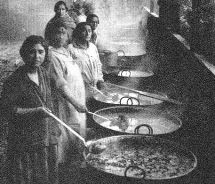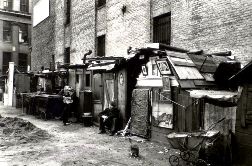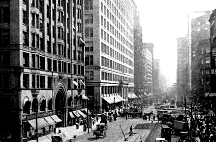|

Soup Kitchens in the Great Depression
|
Soup Kitchens Facts for kids: Fast Fact Sheet
Fast, fun facts and Frequently Asked Questions (FAQ's)
about Soup Kitchens
in the Great Depression
What were the Soup Kitchens during the Great
Depression? The Soup Kitchens during the
Great Depression were places where
hungry men, women and children were served a
free meal, usually consisting of vegetable
soup and bread.
Who ran the Soup Kitchens? The Soup Kitchens
were initially run by volunteers of various
charities. The charities were soon unable to
meet the demand. In 1932, as the hard times
became even worse, President Hoover gave $4
million to the states to open additional
soup kitchens.
Where was the Soup Kitchens?
The Soup Kitchens sprang up in every major
town and city in the United States.
Soup
Kitchens
in the Great Depression Facts for kids
The following fact
sheet contains interesting facts and information on Soup Kitchens
Facts
about the Soup Kitchens in the Great Depression for kids
Soup
Kitchens in the Great Depression Fact 1:
The first Soup
Kitchens were first established in America the 1870's
following the
Panic of 1973 that triggered a previous depression
that lasted for 6 years.
Soup
Kitchens in the Great Depression Fact
2: The idea of soup
kitchens were brought to America by Irish immigrants who
had memories of the events of the 1845 Great Irish
Potato Famine. The Soup kitchens in Ireland, many of
which were run by Quakers, to provide the starving
people with hot soup.
Soup
Kitchens in the Great Depression Fact 3:
The Temporary Relief Act also
known as the Soup Kitchen Act was passed in February 1847 by the
United Kingdom Parliament. It called for the food to be provided
through taxes collected by local relief committees from Irish
merchants and landowners.
Soup
Kitchens in the Great Depression Fact 4:
There were few government
welfare systems before 1935, there was mass unemployment and people
were literally starving. President Hoover believed that private
charities and local communities, not the federal government, could
best provide for those in need.
Soup
Kitchens in the Great Depression Fact 5:
Republican Hoover advocated
"rugged individualism", the idea that every man should fend for
himself and that government handouts to the unemployed did great
damage to people's self-esteem. There was no social 'safety net' of
welfare and relief programs at the start of the Great Depression.
Soup
Kitchens in the Great Depression Fact 6:
Due to Hoover's
beliefs and his slow response to the Great Depression,
the Soup Kitchens provided the main form of sustenance
for the poor, needy, unemployed and homeless
Soup
Kitchens in the Great Depression Fact 7:
1930s soup
kitchens were initially run and funded by charitable
organizations such as churches, religious groups,
missions, Ladies Aid Societies, Women's Leagues and the
Salvation Army. They were dependent on donations from
local businesses and private individuals.
Soup
Kitchens in the Great Depression Fact 8:
The situation
became so dire that in 1932 President Herbert Hoover
authorized $4 million to the states to open more soup
kitchens.
Soup
Kitchens in the Great Depression Fact 9:
Centers were
established in any suitable halls and typically
furnished with long wooden benches and seats that could
seat the maximum number of people in the space available
(as seen in the above picture). Others used any old
furniture donated to charities.
Soup
Kitchens in the Great Depression Fact 10:
Some soup kitchens
sprang up that did not have the facilities or space to
serve food at tables. In these instances people lined up
with their own buckets which the soups were ladled into.
Soup
Kitchens in the Great Depression Fact 11:
Women volunteered
to work in the soup kitchens that served their
communities, improvising cheap recipes for soups that
made use of any available local products. Vegetables,
boiled together in water, made up the bulk of the soups
and stews that were served. As the numbers of people
arriving at the kitchens increased more water had to be
added to the stews and their nutrition value declined.
The soups and stews were cooked in large pots, similar
to those shown in the picture.

Soup
Kitchens in the Great Depression Fact
12: Communities
encouraged more fortunate people to grow "charity
gardens" to supplement the supply of fresh vegetables.
Some city land was also made available for "charity
gardens".
Soup
Kitchens in the Great Depression Fact
13: The quality of the
food served depended on various factors such as how big
the kitchen was, the type of food that had been donated
and how many people there were to feed.
Soup
Kitchens in the Great Depression Fact 14:
Most centers only opened once
a day. However, larger centers were able to open three times a day,
seven days a week offering food or coffee for breakfast, lunch and
supper. The staple diet of the people depending on the centers was
soups, stews and bread. Soups and stews were economical, almost any
ingredient could be used and they were simple and easy to cook and
to serve. Soups were often greasy and watery but it was all that was
available.
Soup
Kitchens in the Great Depression Fact 15:
There were some variations of
the food that was served. Breakfast might consist of just a hot
coffee perhaps with biscuits, muffins, toast and oatmeal. Lunch
consisted of soup, stews, bread or sandwiches often made with peanut
butter, Supper was soups, stews and bread. If fruit was available
some of the kitchens would also provide cobblers or pies. Soups were
made with combinations of meat and vegetables (mostly vegetables).
Continued...
Facts
about the Soup Kitchens in the Great Depression for kids
Facts
about the Soup Kitchens for kids
The following fact
sheet continues with facts about Soup Kitchens for kids.
Facts
about Soup Kitchens in the Great Depression for kids
Soup
Kitchens in the Great Depression Fact
16: The quality of the
food served depended on various factors such as how big
the kitchen was, the type of food that had been donated
and how many people there were to feed.
Soup
Kitchens in the Great Depression Fact 17:
Most centers only opened once
a day. However, larger centers were able to open three times a day,
seven days a week offering food or coffee for breakfast, lunch and
supper. The staple diet of the people depending on the centers was
soups, stews and bread. Soups and stews were economical, almost any
ingredient could be used and they were simple and easy to cook and
to serve. Soups were often greasy and watery but it was all that was
available.
Soup
Kitchens in the Great Depression Fact 18:
There were some variations of
the food that was served. Breakfast might consist of just a hot
coffee perhaps with biscuits, muffins, toast and oatmeal. Lunch
consisted of soup, stews, bread or sandwiches often made with peanut
butter, Supper was soups, stews and bread. If fruit was available
some of the kitchens would also provide cobblers or pies. Soups were
made with combinations of meat and vegetables (mostly vegetables).
Soup
Kitchens in the Great Depression Fact 19:
The comfort of a
hot meal was especially appreciated by the homeless. The
shacks that were built in the shanty towns, called
Hoovervilles, had limited cooking facilities and many
could not afford food to cook. Other homeless people,
especially in congested cities, created really primitive
types of housing with no cooking facilities - the
opposite photo shows a small site in Manhattan, New
York.. For additional facts and information refer to
Shantytowns and
Hoovervilles.

Soup Kitchens in the Great Depression
Fact 20: Al Capone's Soup
Kitchen: The notorious gangster Al "Scarface" Capone,
the wealthy, bootlegging crime boss of the Chicago Mafia
sought to clean up his image by financing one of the
first soup kitchens in Chicago. He earned a reputation
as a 'Modern day Robin Hood' with the poor and destitute
in Chicago who rightly said that Al Capone was doing
more for the unemployed than the US government. As a
benefactor Al Capone attracted newspaper headlines such
as "120,000 meals are served by Capone Free Soup
Kitchen".

Soup Kitchens in the Great Depression
Fact 21: Al Capone's Soup
Kitchen: On Thanksgiving Day in 1930 he provided over
5000 meals in one day. His charitable donations
extended to Christmas as he provided Christmas gifts for
poor and needy children. His generosity and charitable
works also extended to providing coal, clothes and
blankets for the poor the during winter months.
Soup Kitchens in the Great Depression
Fact 22: Al Capone's Soup
Kitchen: Al Capone's Soup Kitchen was located in a store
on 935 South State Street, at the corner of 9th and
State Street in Chicago. It wasn't tucked out of the
way, it was in prominent view to the people of Chicago,
as were the lines of unemployed who waited at the
storefront. Three meals were provided each day for
breakfast, lunch and dinner. For additional facts and
information refer to
Facts about Al Capone

Soup
Kitchens in the Great Depression Fact 23:
In the 1932 presidential election
election Hoover was crushed by Franklin D. Roosevelt and
the Democrats. Relief systems to help the needy were at
last introduced in President Roosevelt's 'New Deal' that
instituted the 3 R's - relief, recovery and reform and
the passage of the Social Security Act.
Soup
Kitchens in the Great Depression Fact 24:
Over 6 million
pigs were slaughtered in September 1933 to stabilize prices during the
Great Depression as a result of the actions initiated by
the Agricultural Adjustment Administration (AAA). Much of the meat went to waste causing
a massive public outcry. In October 1933 the Federal
Surplus Relief Corporation (FSRC) was quickly created to
divert agricultural commodities to relief organizations.
Arrangements were made for flour, pork, apples, beans,
canned beef to be distributed through local relief
channels to the Soup Kitchens, the poor and the needy.
Facts
about Soup Kitchens in the Great Depression for kids
Facts
about
Soup Kitchens in the
Great Depression for kids
For visitors interested in the history of
the Great Depression refer to the following articles:
Soup Kitchens in the Great Depression for kids - President Herbert Hoover Video
The article on the Soup Kitchens provides detailed facts and a summary of one of the important events during his presidential term in office. The following
Herbert Hoover video will
give you additional important facts and dates about the political events experienced by the 31st American President whose presidency spanned from March 4, 1929 to March 4, 1933.
Soup Kitchens in the Great Depression
●
Interesting Facts about Soup Kitchens for kids and schools
●
Summary of the Soup Kitchens in the Great Depression
●
The Soup Kitchens, a major
event in US history
●
Pictures and descriptions of Soup Kitchens
in the Great Depression
●
Fast, fun facts about the Soup Kitchens in the Great Depression
●
Domestic
policies of President Herbert Hoover
● Herbert Hoover Presidency and
Soup Kitchens for schools,
homework, kids and children |